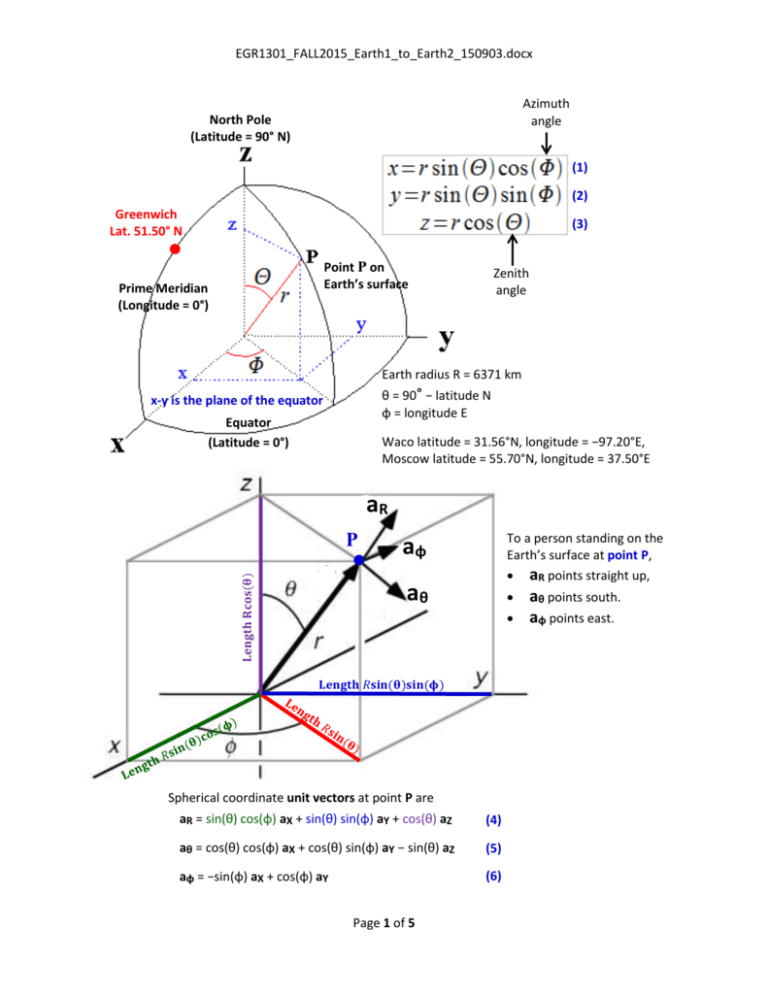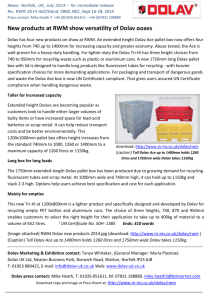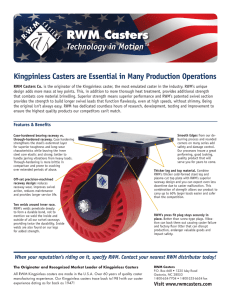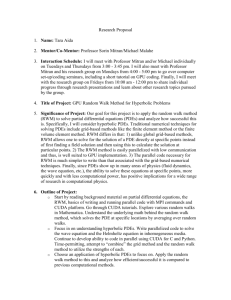EGR1301_FALL2015_Earth1_to_Earth2_150903
advertisement

EGR1301_FALL2015_Earth1_to_Earth2_150903.docx Azimuth angle North Pole (Latitude = 90° N) (1) (2) Greenwich Lat. 51.50° N (3) Point P on Earth’s surface Prime Meridian (Longitude = 0°) Zenith angle Earth radius R = 6371 km θ = 90° − latitude N φ = longitude E x-y is the plane of the equator Equator (Latitude = 0°) Waco latitude = 31.56°N, longitude = −97.20°E, Moscow latitude = 55.70°N, longitude = 37.50°E aR To a person standing on the Earth’s surface at point P, aR points straight up, aφ aθ 𝐴𝜋𝑟 2 𝐋𝐞𝐧𝐠𝐭𝐡 𝐑𝐜𝐨𝐬(𝛉) P 𝐋𝐞𝐧𝐠𝐭𝐡 𝑅𝐬𝐢𝐧(𝛉)𝐬𝐢𝐧(𝛟) 𝐴𝜋𝑟 2 Spherical coordinate unit vectors at point P are aR = sin(θ) cos(φ) aX + sin(θ) sin(φ) aY + cos(θ) aZ (4) aθ = cos(θ) cos(φ) aX + cos(θ) sin(φ) aY − sin(θ) aZ (5) aφ = −sin(φ) aX + cos(φ) aY (6) Page 1 of 5 aθ points south. aφ points east. EGR1301_FALL2015_Earth1_to_Earth2_150903.docx Problem 1. Obtain the vector in x,y,z coordinates that points from Waco to Moscow To obtain the x,y,z vector from Waco to Moscow, first compute x,y,z coordinates at Waco and Moscow using (1), (2), (3). x,y,z coordinates at Waco x = 6371 sin(90° – 31.56°) cos(–97.20°) = 6371 (0.8521) (–0.1253) = –680.2 km x,y,z coordinates at Moscow x = 6371 sin(90° – 55.70°) cos(37.50°) = 6371 (0.5635) (0.7933) = 2848.0 km y = 6371 sin(90° – 31.56°) sin(–97.20°) = 6371 (0.8521) (–0.9921) = –5385.8 km y = 6371 sin(90° – 55.70°) sin(37.50°) = 6371 (0.5635) (0.6088) = 2185.6 km z = 6371 cos(90° – 31.56°) = 6371 (0.5234) = 3334.6 km So, z = 6371 cos(90° – 55.70°) = 6371 (0.8583) = 5263.1 km So, Rw(Center of Earth to Waco), Rm (Center of Earth to Moscow), Rw = –680.2 aX – 5385.8 aY + 3334.6 aZ km and from sqrt(sum of squares), Rm = 2848.0 aX + 2185.6 aY + 5263.1 aZ km and from sqrt(sum of squares), Mag(Rw) = 6371 km (checks out) Mag(Rm) = 6371 km (checks out) Now, starting at the Center of Earth, Rw + Rwm – Rm = 0, where Rwm is a vector from Waco to Moscow. Rewriting, Rwm = Rm – Rw, so Rwm = (2848.0 – (−680.2)) aX + (2185.6 –(−5385.8)) aY + (5263.1 − 3334.6) aZ km. Collecting terms yields the x,y,z vector from Waco to Moscow, Rwm = 3528.2 aX + 7571.4 aY + 1928.5 aZ km (corresponds to 8572.9 km straight line distance through Earth. Problem 2. Convert the x,y,z vector from Problem 1 to spherical coordinates and determine the compass direction at Waco that points toward Moscow. Then, determine Moscow’s tilt angle below the horizon as seen at Waco. To obtain the compass angle heading at Waco, take the dot product of Rwm in x,y,z with the three spherical unit vectors at Waco (expressed in x,y,z). The three components of the dot product and their meanings are Rwm ● aR,w gives the component of Rwm in the aR,w direction (corresponds to straight up at Waco), Rwm ● aθ,w gives the component of Rwm in the aθ,w direction (at Waco, points toward the southern horizon), Rwm ● aφ,w gives the component of Rwm in the in the aφ,w direction (at Waco, points toward the eastern horizon). Page 2 of 5 EGR1301_FALL2015_Earth1_to_Earth2_150903.docx For convenience, Equations (4), (5), (6) are repeated here: aR = sin(θ) cos(φ) aX + sin(θ) sin(φ) aY + cos(θ) aZ (4) aθ =cos(θ) cos(φ) aX + cos(θ) sin(φ) aY − sin(θ) aZ (5) aφ = −sin(φ) aX + cos(φ) aY. (6) The three dot product components become Rwm ● aR is (Rwm,x) (aR,x) + (Rwm,y) (aR,y) + (Rwm,z) (aR,z). Upward, Rwm ● aθ is (Rwm,x) (aθ,x) + (Rwm,y) (aθ,y) + (Rwm,z) (aθ,z). Southern, Rwm ● aφ is (Rwm,x) (aφ,x) + (Rwm,y) (aφ,y) + (Rwm,z) (aφ,z). Eastern, where the spherical unit vector are for Waco. Substituting in (4),(5),(6) yields Rwm ● aR = Rwm,x sin(θ) cos(φ) + Rwm,y sin(θ) sin(φ) + Rwm,z cos(θ). Upward. Rwm ● aθ = Rwm,x cos(θ) cos(φ) + Rwm,y cos(θ) sin(φ) − Rwm,z sin(θ). Southern. Rwm ● aφ = −Rwm,x sin(φ) + Rwm,y cos(φ) . Eastern. Substituting in θ and φ for Waco, the vector toward Moscow has components Pointing Up, 3528.2 (0.8523) (–0.1253) + 7571.4 (0.8523) (–0.9921) + 1928.5 (0.5234) km = –376.7 – 6402.1 + 1009.4 = –5769.4 aR km. Pointing Toward the Southern Horizon, 3528.2 (0.5231) (–0.1253) + 7571.4 (0.5231) (–0.9921) – 1928.5 (0.8523) km = –231.3 – 3929.3 – 1643.7 = –5804.3 aθ km. Pointing Toward the Eastern Horizon, –3528.2 (–0.9921) + 7571.4 (–0.1253) km = 3500.3 – 948.7 = 2551.6 aφ km Mag check = sqrt(5769.4^2 + 5804.3^2 + 2551.6^2) = 8572 km (checks). Referring to the Figures on the Next Page: Azimuth angle = arctan(east/north) = arctan(east/(–south)) = arctan(2551.6/(-5798.3)) = 23.8⁰. Azimuth angle is compass angle but without magnetic declination factored in. At Waco, compass points 4.5⁰ east of north. Thus, the observed compass angle is 23.8 – 4.5 =19.3⁰. Zenith angle = arccos(up/Mag) = arccos(-5769.4/8572) = 132.3⁰. Zenith angle = 0 corresponds to straight up, 90 degrees is tangent to the Earth, and 180 degrees is straight down. Thus, Moscow is 132.3 – 90 = 42.3⁰ degrees below the horizon. Page 3 of 5 EGR1301_FALL2015_Earth1_to_Earth2_150903.docx True North at Waco Moscow – aθ Standing on the Earth at Waco, Looking Straight Down. Align this graph with true north, and stand on it. A step along the dashed line is a step toward Moscow. If you used compass north instead of true north, rotate the paper counterclockwise by 4.5° . 23.8° 5804 km north The projection of the Moscow vector tangent to the Earth’s surface at Waco is sqrt(2552^2 + 5804^2) = 6340 km long. Waco aφ 2552 km east Waco 6340 km tangent to Earth at Waco Side View of Earth. The vertical cross section contains Waco, Moscow, and center of Earth. You can see that the Moscow vector points at an angle that is arctan(5769 / 6340) = 42.3⁰ degrees below the horizon at Waco. The distance along the Earth’s surface to Moscow is nearly one-fourth the circumference of the Earth. 42.3° 5769 km toward center of Earth 8572 km Earth radius 6371 km – aR Moscow Center of Earth Page 4 of 5 EGR1301_FALL2015_Earth1_to_Earth2_150903.docx Page 5 of 5









